Planting garden blueberries in spring and autumn
Blueberries are eaten with pleasure from the bush, added to yoghurts and desserts, they even make jam and put them in porridge. And all because it is an amazingly tasty and healthy berry. Gardeners who decide to acquire bushes in their summer cottage garden should know all the nuances of the correct planting of blueberries and care. Since it is on this process that its further fate and fertility depends.

Content
When is it better to plant blueberries: features of spring and autumn planting
The optimal time for planting garden blueberries in spring is in mid-April and in autumn in October. Both spring and autumn planting have a common disadvantage: due to sudden frosts, the plant can freeze out.It is better to plant blueberries in autumn, since the survival rate of plants at this time is much higher, and the planting material, as a rule, is of better quality.
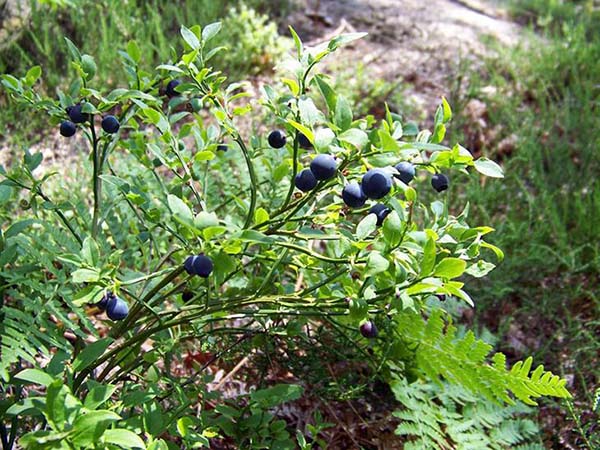
How to plant blueberries: features and step-by-step instructions
Blueberry is a plant that is extremely demanding on soil and the environment. So, in order for the shrub to take root and soon delight with sweet and sour fruits, you need to follow a number of rules for planting and caring for garden blueberries.
What should be a seedling
The best planting material for blueberries is 2 or 3 year old seedlings with closed root system... Of course, bushes with open roots can also be planted, however, on the counter they dry out very much, as a result of which they do not take root well. The bushes should look healthy and the roots should be visible from the drainage holes. Before planting, the young plant is carefully removed from the container, the roots are straightened, and the shoots are shortened to a height of 20-30 cm.
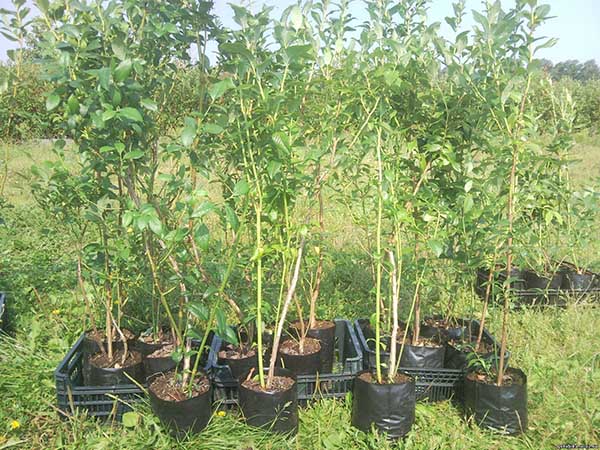
Landing place
Due to the fact that under natural conditions blueberries grow in forests, it is best to plant a plant in the country. in partial shade... But it is undesirable to plant a plant in the shade: due to a lack of sunlight, the berries will be sour. The shrub can also be grown in a sunny area, but in order to collect a good harvest, it must be sprayed 3-4 times a day. The ideal place to plant garden blueberries is near deciduous and coniferous trees.

In summer cottages with loose soil, blueberries can be planted in a place where groundwater flows at a distance of 30-90 cm from the surface. It is impossible to plant a bush where water stagnates for a long time.
What to plant with
Due to the fact that blueberries do not like organic matter, it is forbidden to plant shrubs near crops that are regularly fed with such fertilizers. The fact is that dung and chicken litter strongly alkalize the soil, which is extremely undesirable for such a lover of an acidic environment like blueberries. A shrub growing in an area where soil pH exceeds 5.5 becomes sick, stops growing and dies.
At what distance
In order for the shrub to have enough moisture and nutrients, the distance between the bushes should be 0.6-4.5 m. For blueberries narrow-leaved varieties enough 60 cm of free space, scutellous - 1.8 m. Bushes belonging to rod-like, planted at a distance of 4.5 m with a row spacing of 2.5 m.
What soil is needed
Unlike many cultivated plants, blueberries prefer to grow not on neutral, but on acidic soils. So, the best medium for the growth of a berry is a substrate, the acidity of which is 3.5-5 units. To bring the acidity to the desired level, the planting pit is filled with a mixture of fertile soil and peat chips (2: 1). In order to acidify the substrate even more, 150-200 g of sulfur are added per 1 square meter. River sand or sawdust is introduced into heavy soils.
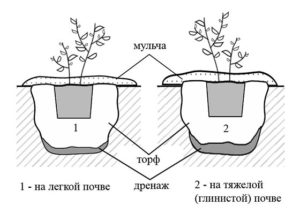
Landing pit
To plant garden blueberries, dig a hole 60 × 60 cm deep 50-80 cm. A layer of broken brick, pebbles or rubble is laid on the bottom. Then the planting hole or trench is covered with the prepared substrate for most of it and left to stand for 2-3 weeks. In order for the earth to settle, the preparation of the deepening begins one month before the expected date of planting.
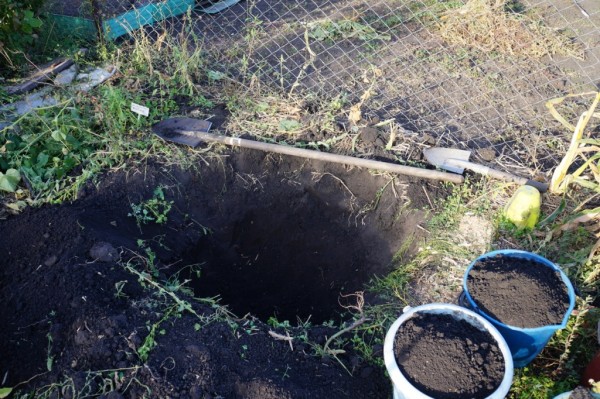
How and what to fertilize before planting
Since blueberries love an acidic environment, the soil for filling the pit is mixed with high peat, coniferous sawdust or rotted oak leaves. To acidify the soil, colloidal sulfur is poured into the pit or poured with a solution of citric acid (1 tablespoon of the substance per bucket of water).
Important! Do not use organic fertilizers in the blueberry planting pit, as they alkalize the soil.
Planting methods
When planning the appearance of a summer cottage, it is important to choose the right method of planting certain plantings. Blueberries, like all shrubs, are planted in the following ways:
- Into the ranks. If you want to equip a hedge or large plantations, the plants are planted in one or more rows at a distance of 2.5 m. Using this method, the bushes are placed both in separate holes and in trenches. However, the second method is quite costly, since its implementation requires a lot of peat and coniferous sawdust.
- Planting in barrels or containers. Drainage holes with a diameter of 5 cm are made in the bottom of the containers with a depth of 60 cm. A hole of the appropriate size is dug at the chosen place and the container is immersed in it. Further, the container is covered with a substrate and a bush is planted.
- To the ridges. In places where water stagnates for a long time, blueberries are planted on homemade hills. At the chosen place, a mound of substrate is poured with a height of 20-30 cm and a width of 0.9-1.2 m. The mound is fenced with boards of appropriate size made of hardwood trees - acacia, cedar and oak. Such wood is practically not subject to decay and will last a very long time.
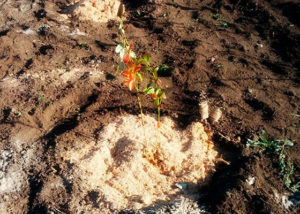
Features of growing blueberries from seeds
The enthusiastic gardeners who love to watch every stage of growth grow blueberries with seeds. This method is not very popular with novice breeders, since it takes a very long time to wait for the first harvest.
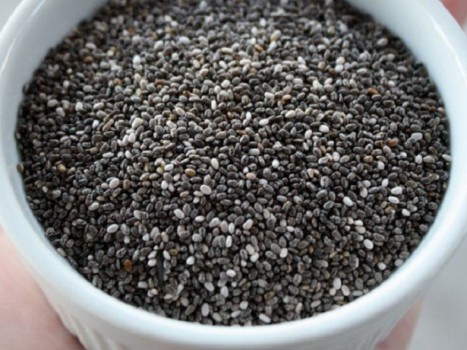
Planting blueberries with seeds is done as follows:
- Ripe or melted after freezing berries are thoroughly kneaded in hand, and then the resulting gruel is poured into a container with water.
- The mixture is stirred until the rind and empty seeds emerge.
- The garbage is drained and the seeds are washed with water.
- The clean planting material is shaken out of the container, slightly dried and sown in seedling boxes filled with peat.
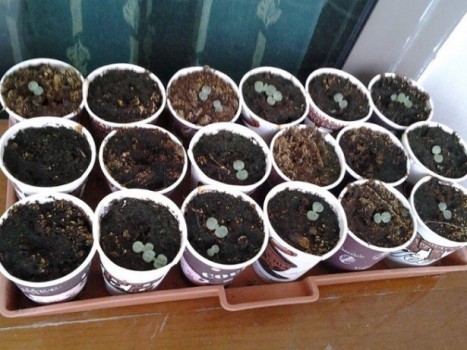
After 2-3 weeks, when the seedlings have risen, the temperature in the room is gradually lowered to + 5- + 10 C. In the spring, the strengthened plants are transplanted into larger pots. In open ground, blueberry seedlings are planted at the age of 2 years.
Video: planting and growing blueberries from seeds
Care after landing
In order for the plant to take root and begin to grow rapidly, it needs to provide the most comfortable conditions. What should be included in the care of blueberries after planting?
- Watering. The first watering is done immediately after planting. Throughout the season, the root system of the shrub should be in moist soil. Therefore, the state of the earthen coma is closely monitored and, if necessary, watered moderately. On the hottest days, 10 liters of water are added under the plants 2 times a week. To maintain the required acidity, citric acid is added to the water for irrigation once a month.
Important! Despite the fact that blueberries love moisture, the soil around them cannot be turned into a swamp: lack of air and a large amount of moisture are the main reasons for root rot.
- Top dressing. Immediately after planting, root and foliar dressing is carried out with nitrogen, phosphorus or complex fertilizers, previously diluted in water. To neutralize the effect of nitrogen, colloidal sulfur is added to the mixture. The roots take up nutrients better if the fertilizer temperature is several degrees higher than the air temperature. Spraying is carried out with complex mineral fertilizers, to which fungicides and insecticides are added. Top dressing is best done in the evening. In autumn, blueberries are fed with complex mineral fertilizers. The dose of the nutrient mixture is determined based on the manufacturer's recommendations, the condition of the soil and the age of the plant.
- Mulching. Mulch will help protect the root system from drying out. A layer of coniferous litter, sawdust, crushed pine bark is laid around the bush. The thickness of the shelter should be 4-5 cm.

- Loosening. In the absence of mulching material, the trunk circle is regularly loosened. The manipulation must be carried out extremely carefully, since the bulk of the plant roots lies at a depth of 15-20 cm.
- Pruning. Before the buds swell, dried or frozen branches are removed from the crown of plants planted in autumn.Extra shoots are carved from the bushes 3-4 years old, and all the rest are trimmed to the same level. In the future, sanitary pruning of blueberries is carried out annually, and upon reaching 15 years, in order to be late, the bush is cut to a level of 20 cm.
Video: garden blueberries - advice for gardeners
Landing features in different regions
Since blueberries are highly frost-resistant, the plant is grown throughout the country. However, due to the varied weather conditions, landing in the regions has some differences.

In the Volga region
In autumn, blueberries are planted in the first or second decade of October, and in spring - in the third decade of March. If severe frosts are foreseen in the region, the seedlings are covered with dense spunbond or ordinary rags.
In the middle lane (Moscow region)
Autumn planting is done in mid-October, spring planting at the end of March-April. Since the conditions of the Moscow region are very moderate, this is where the peculiarities of planting shrubs end.
In Siberia and the Urals
Since the winter of these regions is characterized by its harsh conditions, blueberries are planted in autumn in late September and early October, and in spring in April. In order to give looseness to the heavy soil characteristic of the region, sand or coniferous sawdust is added to the planting substrate.
Possible mistakes when planting blueberries
Due to poor knowledge of the features of garden manipulation, novice gardeners are mistaken even in the most elementary things, let alone planting demanding blueberries. Here are some of the most common mistakes:
- Strong waterlogged plant. Constant exposure to high humidity even for moisture-loving blueberries ends in death.
- Plant planted in sunny areas and don't look after him. Without frequent spraying, the berry dries up.
- As a top dressing use organic.
- Bushes are planted too close to each other.
Planting and caring for garden blueberries in the country is not as difficult as it seems: all the shrubs need is acidic and nutritious soil, which allows air and water to pass well to the roots, as well as careful and proper care of the gardener.
Video: how to plant blueberries correctly

